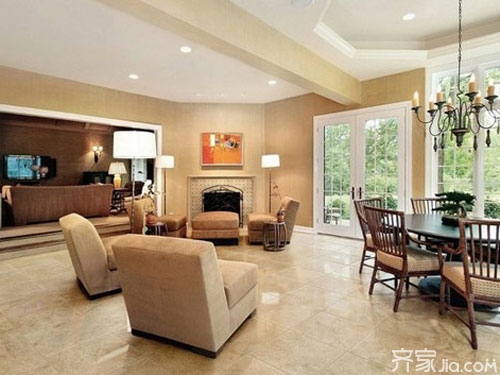Wall tiles in renovation are one of the essential decoration materials. How about the tile laying method? Tile paving construction process is very particular about, good technology, not only can make your interior space beautiful and smart, but also save you a lot of money, but also save you a lot of money. The following Xiaobian provides some information for everyone, hoping to help you.

Wall tile laying construction process
1, grassroots inspection processing:
(1) The pits on the ground, the holes, and the trenches for the buried pipes shall be smoothed out in advance. Dust, oil or other impurities and attachments on the ground shall be cleaned; the ground shall be fully wetted;
(2) The water-cement ratio is 0.5 gram cement slurry brush again, the ground must not have water, then semi-dry concrete shop (cement, sand volume ratio of 1:2);
(3) The water-cement ratio is 0.5 s cement slurry brush (with the shop with the brush, keep the slurry surface moist), the ground may not have water.
2, determine the elevation point:
(1) The 1m elevation line is popped up on the surrounding walls and pillars. The error cannot exceed 2mm.
(2) Elevation surface of the surface is completed by popping the surface of the walls and pillars. The error cannot exceed 2 mm.
(3) Ground paved elevation line: The surface elevation must be controlled according to the surface elevation line of the wall surface and cylinder surface to complete the elevation error of the surface can not exceed 2 mm.
3, choose brick, dip brick:
(1) Before the brick is immersed in water, check the color difference, straightness, and warpage of the brick. Spots, interlayers, blisters, caverns, bumps, pits, cracks, peels, and glazes are not required. Flatness, straightness deviation is greater than or equal to 0.5mm, and straight angle deviation is greater than or equal to 0.6mm. Never use it.
(2) Bricks are soaked in water 2 hours in advance, fully moistened, and dried to the surface without water.
4, shop semi-dry mortar:
(1) Width is spread over bricks, cross-striped semi-dry mortar, and the dryness and wetness of the mortar. The mortar is squeezed into groups and the ground will automatically spread evenly. (The ratio of cement to sand is 1:3)
(2) After spreading the surface layer, brush the cement paste layer on one side and spread the concrete on one side. When the concrete exceeds 30mm, the load and construction change visa must be confirmed.
5, try out the test to fight:
According to the design and process conditions, try to arrange bricks, check the situation with the entrance, column, wall position of the block cutting;
6, tiling:
(1) Tile order: Tiles shall be tiled in units of 8mx8m squares, and the paving order shall follow the following principles: first in the outside, first in the middle, then in the doorway, and in the aisle, from the central point of 8mx8m square to the surrounding Stickers, if the bricks are all bricks around, you can stick them from the side.
(2) Paving method: Before the paving, firstly pull the horizontal line of the cross ground level, lay the cross control bricks according to the horizontal line of the cross ground, and then stick them around according to the cross control bricks, and check the leveling with the 2m ruler and the horizontal ruler at any time. degree.
The floor tiles are laid smoothly, and the plates are struck with a rubber mallet to loosen the concrete; the plate is uncovered and the plain grout with the water-cement ratio of 0.45 is evenly touched on the back of the bricks, the thickness is controlled at 5-7mm; the bricks are laid flat When lifting the position, use a 5mm cross card to control the brick seams, and then use the rubber hammer to strike the plate to the height of the standard brick. Clean the mud on the brick and check with the ruler and level ruler before proceeding with the next piece of the tile. The height is too low or the location is inaccurate and should be reopened after reopening. After the tiles are well-laid, the brick surface is cleaned with the cement mortar.
7, hooking: after tiling brick surface strength can reach the person, the jointing, staggering designated professional use Wal-Mart, jointing requirements clear, straight, flat, consistent depth, seam should be lower than the brick surface 0.5- 1mm.
8, conservation, self inspection, protection
(1) Paved bricks shall not be heavily stressed, exposed or subjected to vibration within 3 days;
(2) Check for defects such as empty drums, uneven paving, and inconsistent seam width after 3 days, and rework should not be required;
(3) Within 24 hours of paving good bricks, sprinkler shall be used for conservation and maintenance. The time for conservation shall not be less than 7 days. For paving the ground, paper products, wood boards, and carpet-covered tiles shall be used to protect the ground.

Wall tiles and floor tiles laying construction process considerations
1. First, the wall tiles should be laid up from the bottom up, and one wall can not be attached to the top at one time. The seams are generally 1~3 mm; the second is to deal with the smoothness of the wall surface to deal with cracks before paving; third is the bonding material. The smear should be slightly higher in the middle than it is around, and use a rubber hammer to strike the surface to fix it. This will prevent air from accumulating in the adhesive layer. At the same time to carry out the level of testing; Fourth, the adhesive material to be stirred properly, the general wall cement and sand ratio of 1:4, the ratio of ground cement and sand is 1:3.
2, the ground should be tied. There are some civil grounds that are uneven. In this case, everyone should use the cement mortar to level uneven areas. When laying, different colored tiles (darker colors) can be used to frame the surroundings while the tiles in the frame are lighter. Of course, the floor of the kitchen and the toilet must have an inclination. This is to facilitate drainage.
3, tile decoration Another thing to note is the treatment of the waterproof layer. The walls in the kitchen and toilet areas should be highly noted. Because replacing the tiles usually damages the original cement pad waterproof layer. The remedy is to apply a layer of bituminous waterproofing before plastering. Tiles filled with white cement should also be filled.
4, the brick surface should be flat, the angle should be accurate, the interface should be on the line; the tiles should be immersed in water for half a day before use; the toilet floor should have a proper slope, can not use water after the white tile cement with white rattan brush clean white cement, Do not leave cement on the surface of the bricks. After the tiles have been laid, cover them with cardboard, etc., and wait at least 24 hours before walking on the tiles.

Tile surfacing acceptance criteria
1. Pay attention to whether tiles need to be parqueted or laid in a uniform direction.
2. The leveling of floor tiles shall be checked with a 2-meter level ruler, the error shall not exceed 0.5mm, the height difference between adjacent tiles shall not exceed 0.5mm, and the gap flatness shall be 3mm. When the tiles are laid, other types of work shall not be polluted and shall not be trampled upon. After the tiles are finished, they will be sewn 24 hours after the completion of the floor tiles, cleaned, and cured.
3, floor tile hollowing phenomenon is controlled within 3%, the empty channel on the main channel must be rework, 3% single refers to a single piece of empty corners, the whole block must not empty.
4. After the floor tiles are finished, check whether the flatness has any errors, empty drums, color differences, etc., then cover and protect them with cardboard or plywood, old carpets, etc. The space between the boards must be tightly taped with a wide paper tape to prevent the entry of sundries.
5, under normal circumstances, the level of floor tiles allowed to have an error of 2 mm, floor tiles must be the same gap, the brick and brick should be flat (allow 0.3 mm error), kitchen, bathroom wall tiles in addition to brick and brick The corners should be flat, but also need to be level (allowing 1mm error) and verticality (allowing 2mm error) to be achieved. Bathrooms and balconies need to be floor drained, and the slope should be put first. If there is no special reason, there must be no Water.
6. After the wall tiles and floor tiles have been laid out, the “seam sealant†or “white cement†shall be used to fill the wet pulp.
7. Whether the gaps in the brick surface are regular and uniform, the joints are even and tidy, the brick joints do not exceed 1mm, and the tile errors do not exceed 20px.
8. Whether the toilets, balconies and kitchen floor tiles with floor drains have sufficient self-drainage inclination.
9. Does the brick surface have broken and collapsed angle?
10. Is the tile orientation correct and there is no reversal.
11. Whether the tile and waistline position is correct, there is no biased position or the height is wrong.
The above mentioned construction techniques and acceptance standards for tile and paving are briefly introduced here, and we hope to help you. For more information, please visit this website. Stay tuned.
Tiles
Cotton Rope,Braided Cotton Rope,Macrame Cotton Rope,Macrame Rope
Baoying Yiliyuan Rope And Net Co.,Ltd , https://www.ylyropes.com
